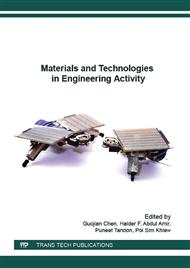[1]
R. Hague, S. Mansour, N. Saleh, R. Harris, Materials analysis of stereolithography resins for use in Rapid Manufacturing, J. of Mat. Sci. 39 (2004) 2457–2464.
DOI: 10.1023/b:jmsc.0000020010.73768.4a
Google Scholar
[2]
S. M Peltola, F.P.W. Melchels, D.K. Grijpma, and M. Kellomäki, A review of rapid prototyping techniques for tissue engineering purposes, Ann. Med. 40 (4) (2008), 268–280.
DOI: 10.1080/07853890701881788
Google Scholar
[3]
J. Wieding, A. Wolf, R. Bader, Numerical optimization of open-porous bone scaffold structures to match the elastic properties of human cortical bone, J. Mech. Behav. Biomed. Mater. 37 (2014) 56–68.
DOI: 10.1016/j.jmbbm.2014.05.002
Google Scholar
[4]
A. Butschera, M. Bohnera, C. Rothc, A. Ernstbergera, R. Heubergera, N. Doebelina, P. R. V. Rohrc, R. Müllerb, Printability of calcium phosphate powders for three- dimensional printing of tissue engineering scaffolds, Acta Biomater. 8 (1) (2012).
Google Scholar
[5]
S. Kumar, J.P. Kruth, Composites by rapid prototyping technology, J. Mater. Des. 31 (2) (2010) 850–856.
Google Scholar
[6]
A. Farzadi, V. Waran,M. S. Hashjin, Z.A.A. Rahman, M. Asadi, N. A. A. Osman, Effect of layer printing delay on mechanical properties and dimensional accuracy of 3D printed porous prototypes in bone tissue engineering, J. Ceramics International. 41 (2015).
DOI: 10.1016/j.ceramint.2015.03.004
Google Scholar
[7]
M. S. Hossain, J. Ramos, D. Espalin, M. Perez, R. Wicker, Improving Tensile Mechanical Properties of FDM-Manufactured Specimens via Modifying Build Parameters, J. Utwired. Engr. Utexas. Edu. 11 (2013) 380-392.
Google Scholar
[8]
A.R. Torrado-Perez, D.A. Roberson, R.B. Wicker, Fracture Surface Analysis of 3D Printed Tensile Specimens of Novel ABS-Based Materials, J. Fail. Anal. and Preven. 14 (2014. ) 343–353.
DOI: 10.1007/s11668-014-9803-9
Google Scholar
[9]
S.H. Ahn, M. Montero, D. Odell, S. Roundy, P.K. Wright, Anisotropic material properties of fused deposition modeling ABS, J. Rapid Prototyping. 8 (2002) 248– 257.
DOI: 10.1108/13552540210441166
Google Scholar
[10]
A. Bellini, S. Guceri, Mechanical characterization of parts fabricated using fused deposition modeling, J. of Rapid Prototyping. 9 (2003) 252–264.
DOI: 10.1108/13552540310489631
Google Scholar
[11]
B. Caulfield, P. E. McHugh, and S. Lohfeld, Dependence of mechanical properties of polyamide components on build parameters in the SLS process, J. of Materials Processing Technology. 182 (2007) 477-488.
DOI: 10.1016/j.jmatprotec.2006.09.007
Google Scholar
[12]
M. Vaezi, C. K. Chua, Effects of layer thickness and binder saturation level parameters on 3D printing process, J. Advanced Manufacturing Technology. 53 (2011) 275-283.
DOI: 10.1007/s00170-010-2821-1
Google Scholar
[13]
Information on http: /teststandard. com/data_sheets. html.
Google Scholar
[14]
S. Mohanty, S.K. Nayak, B.S. Kaith, S. Kalia, Polymer Nanocomposite based on Inorganic and Organic Nanomaterials, Scrivener Publishing, Wiley, 2015, pp- 113-122.
DOI: 10.1002/9781119179108
Google Scholar


